Each product in your store can be edited at any time if you need to update pricing, the description, the images, etc. On this page, you’ll learn about each of the settings in the Product editor and how to edit each one.
What are the settings in the WooCommerce Product Editor
↑ Back to topThe Product Editor can be found by navigating to Products > All Products and clicking edit on a product you want to modify. Below are the settings you can modify in the product editor:
- At the top of the page is the Product name field.
- The largest input field is the Product description field located below it.
- Next is Product data.
- Then Product short description.
- At the bottom is Reviews.
- In the column on the right, at the top, is Publish.
- Below that is Product image.
- Then Product gallery.
- Followed by Product categories.
- And lastly, Product tags.
- Two additional panels, Custom Fields and Slug, are hidden by default.
You can change the order of settings panels (except for Product Name and Product Description), and you can toggle the visibility of some panels on or off using the “Screen Options” tab at the top right of the screen. Remember that some themes and page builders override the default appearance of the Edit product screen entirely.
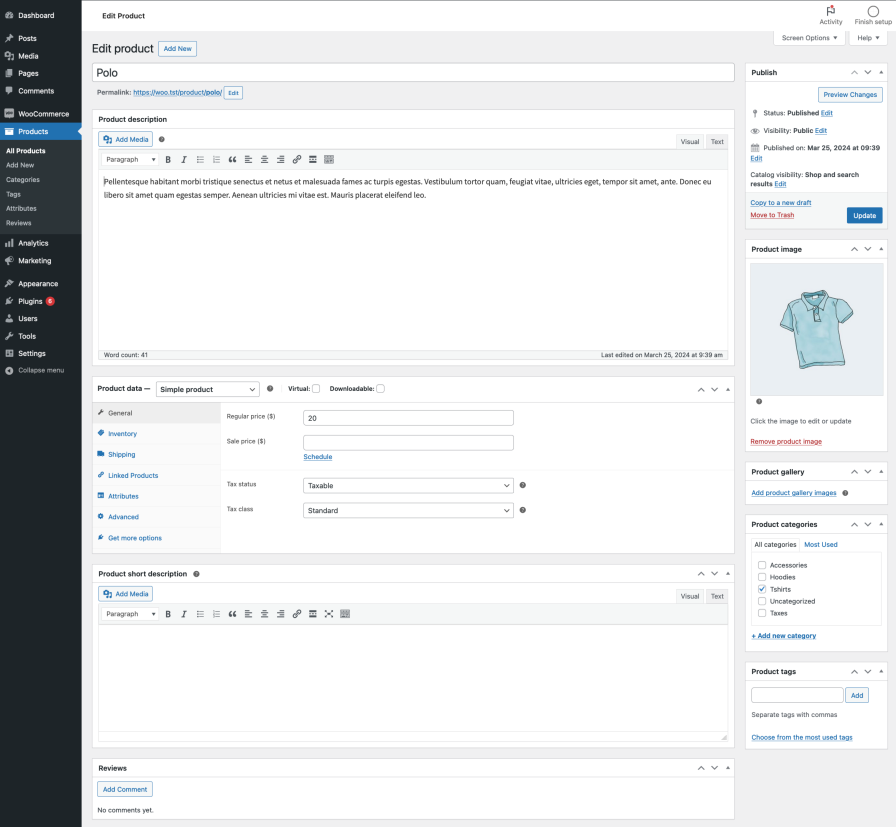
Let’s take a closer look at the settings.
Product name
↑ Back to topThe Product name field is for the name of your product.
This field also auto-generates a slug for new products, which is the final segment of a product’s URL. The field accepts letters, numbers, special characters, emojis, and even HTML. Changing the title of an existing product does not alter the slug. To change the slug, you can use the “Edit” button that appears next to the URL below the Product name field after the initial save, or you can modify it through the Slug panel.

Product description
↑ Back to topThe Product description is for the detailed description of your product. This field will accept just about any type of content including text, image and video embeds, tables, HTML(using the “text” tab in the editor), or whatever else you may need to convey the value and benefits of a product to your customers.
Product data
↑ Back to topThe Product Data panel is where to add the majority of important data about your products.
At the top of the box is Product type which always defaults to Simple product. Next to it are 2 checkboxes, Virtual and Downloadable. The state of these 3 together influences the visibility and content of each of the sections in this panel. The default sections are General, Inventory, Shipping, Linked Products, Attributes, Advanced, and Get more options.
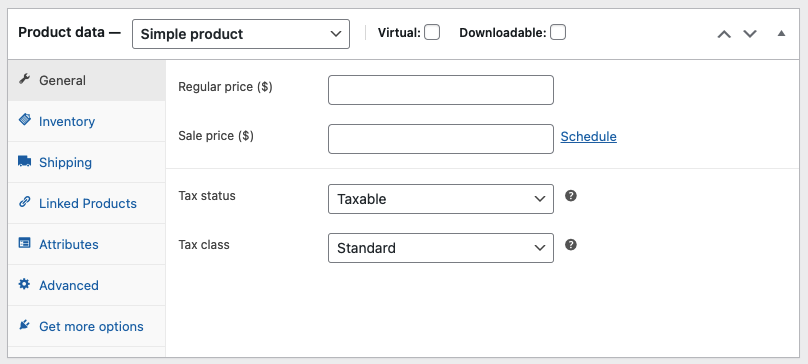
Product Type
↑ Back to topSome product types may require different treatment and show more settings than others, so it’s vital to decide which type the product you’re adding. WooCommerce includes the following default product types:
- Simple – covers the vast majority of products you may sell. A simple product requires no consideration from the customer’s point of view beyond buying it or not. It defaults to being a physical product, which means shipping applies.
- Grouped – A container holds various products, forming a collection for customers to purchase together.
- External or Affiliate – List and describe products on your website that are sold elsewhere.
- Variable – a product with variations, each of which may have a different SKU, price, stock options, and shipping settings. For example, a t-shirt available in different colors and sizes.
- Other extensions might add more product types here, and their documentation should cover those.
The Virtual and Downloadable settings are available for Simple products and the variations of Variable products.
- Virtual – a virtual product (e.g. a service) doesn’t require shipping. When checked, this option disables the Shipping section. A virtual product by itself does not trigger the shipping calculator in cart and checkout (although any physical products purchased in the same order still have shipping applied).
- Downloadable – checking this option activates additional fields where you can provide a downloadable file. After customers make a successful purchase, the order notification email sends them a download link. This option suits products that are, for example, a digital album, a PDF, or a photo. It relies on Downloadable product settings.
General section
The General section is where you configure essential product data. It’s visible for Simple, External/Affiliate, and Variable product types, but contains more or fewer settings depending on the selected product type. The products in the group provide information to the grouped products.
Simple and External/Affiliate include the following settings. For Variable products, each variation has its own settings, which are not in the General sections. [LINK](https://woo.com/document/variable-product/#adding-variation-data).
- Regular price – the regular price of the item.
- Sale price – If you enter the discounted price for the item, it will show. Clicking the Scheduled link adds two additional fields:
- Sale price dates – from: the date on which the sale price should start displaying.
- Sale price dates – to: the date on which the sale price should stop displaying (expires at 11:59pm).
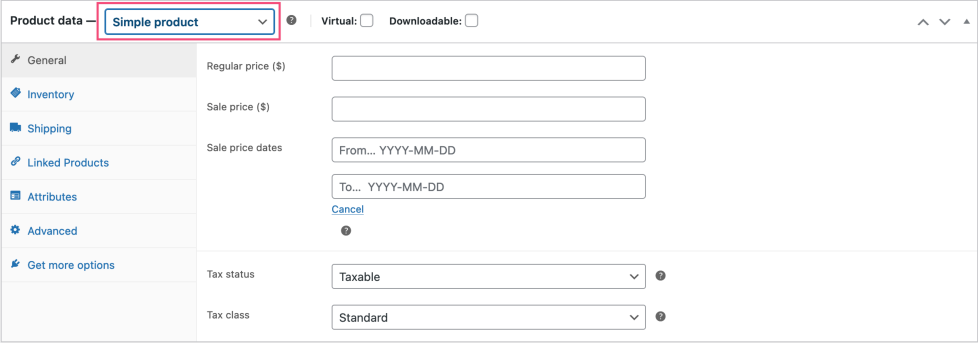
Simple, External/Affiliate, and Variable product types include these settings.
- Tax status –You can set it to Taxable, Shipping only, or None.
- Tax class – It defaults to Standard, but you can assign other tax classes.
Refer to the Variable products documenation for a detailed look at variations specifically.
External/Affiliate product type also has these additional settings:
- Product URL – customers can buy the product at this external URL.
- Button text – The button that links to the external product will display the text you enter here.
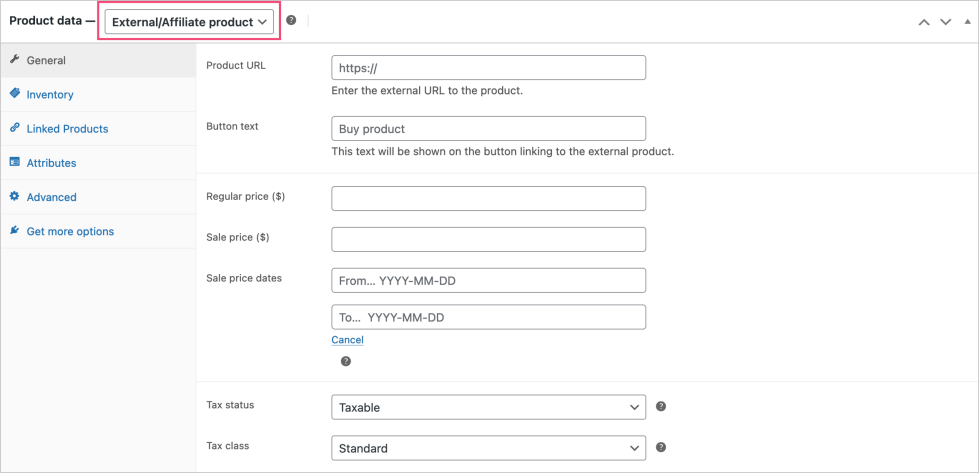
Inventory section
The Inventory section allows you to manage stock settings related to an individual product and override some of the site-wide settings (configured under Products > Inventory > Manage stock).
Grouped and External/Affiliate show only the SKU option, while the Single product type includes all the options. The Variable type shows all options unless otherwise stated.
- SKU (optional) – the SKU (Stock Keeping Unit) is a unique reference that identifies individual items. It accepts alphanumeric values and some special characters explained in more detail here.
The SKU (Stock Keeping Unit) is a unique reference assigned to a product to improve searchability and for the purpose of keeping track of inventory. The SKU field accepts up to 255 characters, including alphanumeric values and special characters. It most commonly consists of alphanumerals and a dash, e.g. SKU-501-RED.
The input is validated by the WordPress function santize_text_field, which strips out HTML, invalid UTF characters, and octets (an octet is defined by % followed by 2 characters with a value in the range of a-f or 0-9).
- Stock management – Visible only if you enable “Manage stock” under Products > Inventory.
- If you don’t check Stock management, the product’s stock status relies on the next setting, Stock status. Alternatively, for a Variable product, it uses the variation-level setting.
- If you check Stock management, it uses the Quantity setting below.
- Stock status – It becomes visible if you don’t check Stock management. Options include:
- In Stock – sales can continue indefinitely.
- Out of stock – The item is out of stock, it can’t be purchased.
- On backorder – Customers can buy the product, but a notice indicates it’s on backorder, signaling a delay because it needs time to restock.
- Quantity – It’s visible only when you check Stock management. Add the specific availability of an item, so WooCommerce can keep track and automatically set the item as out of stock when depleted. On a variable product, this quantity includes all variations.
- Allow backorders? – only visible when Stock management is checked. Options include:
- Do not allow – customers cannot backorder products.
- Allow, but notify customer – allows backorders and displays a notice to inform customers.
- Allow – allows backorders and to customers it appears no different than an in-stock item.
- Low stock threshold – visible when Stock management is checked. The stock level at which the store manager is notified via email. By default, it displays the store-wide level, but you can override it on the product or variation level.
Sold individually – when checked, this option allows customers to only purchase 1 of this item per order. Useful for items that have limited quantities. However, it does not prevent customers from making multiple orders and purchasing the item again.
Note: by default “In Stock” will only be displayed on the product page if a product’s Track stock quantity option is enabled under the Inventory tab. A snippet in the WooCommerce settings docs can be used to force the display of “In Stock” for products that are in stock, even if the quantity is not tracked.
Shipping section
The Shipping section is where to add data relevant to the shipping of a product. The Shipping section only appears on Simple and Variable product types not marked as Virtual. For Variable product types, these settings apply to all variations unless you add specific settings for each variation.
- Weight – weight of the item (units can be configured under WooCommerce > Settings > Products > General).
- Dimensions – length, width and height for the item.
- Shipping Class – Certain shipping methods use shipping classes to group similar products.
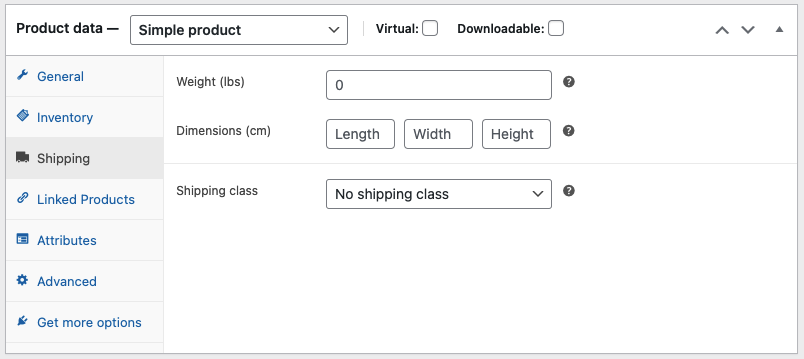
Linked Products section
In the Linked Products section, you can add products for cross-promotion as upsells (a product that is more beneficial for you or your customer) or cross-sells (a complementary product). Add products by clicking in the respective field, searching, and selecting a result. This section is available for all product types.
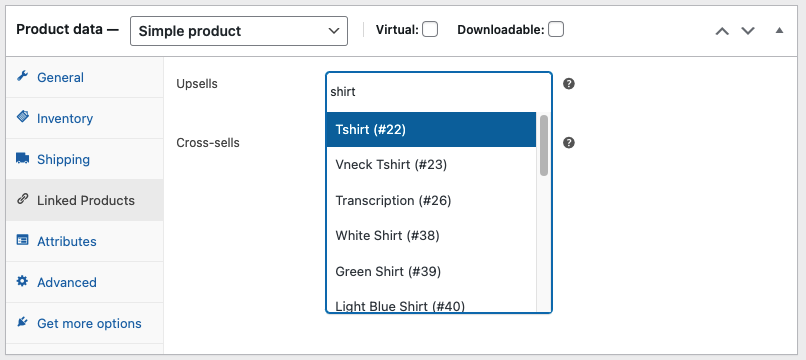
Upsells
The product details page displays up-sells. These are products you want to encourage customers to upgrade to, based on the product they are currently viewing.
For example, if a customer looks at the Comfy Chair 3000 while browsing for office chairs, you can offer the Comfy Chair 4000 as an up-sell. It has a cup holder! (It also has better margins making it a more beneficial sale for you too).
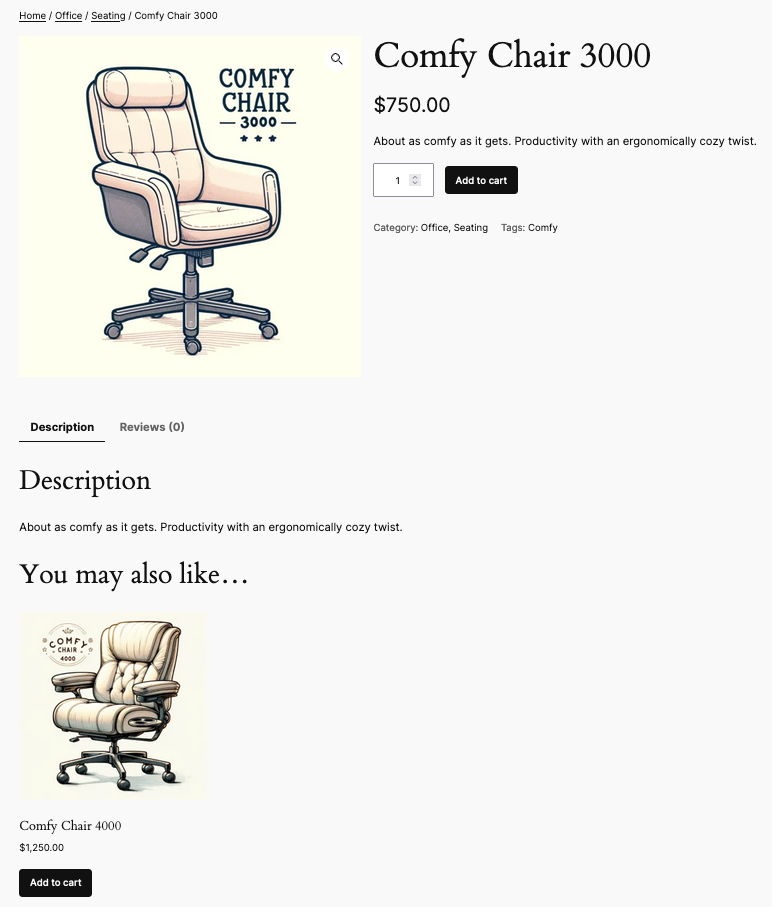
Cross-sells
Cross-sells display with the cart and relate to the user’s cart contents. By suggesting additional products that complement or connect to the items the customer is considering, you can boost your average order value.. This could include accessories or related products that enhance the main product’s value.
To extend our above example, if the customer opted to purchase the Comfy Chair 4000 for its cup holder, we suspect they value having a drink nearby. Based on that we can present a vacuum flask as a cross-sell, because it’s custom-made for the chair’s cup holder and the perfect complement. Cross sells show on the cart page
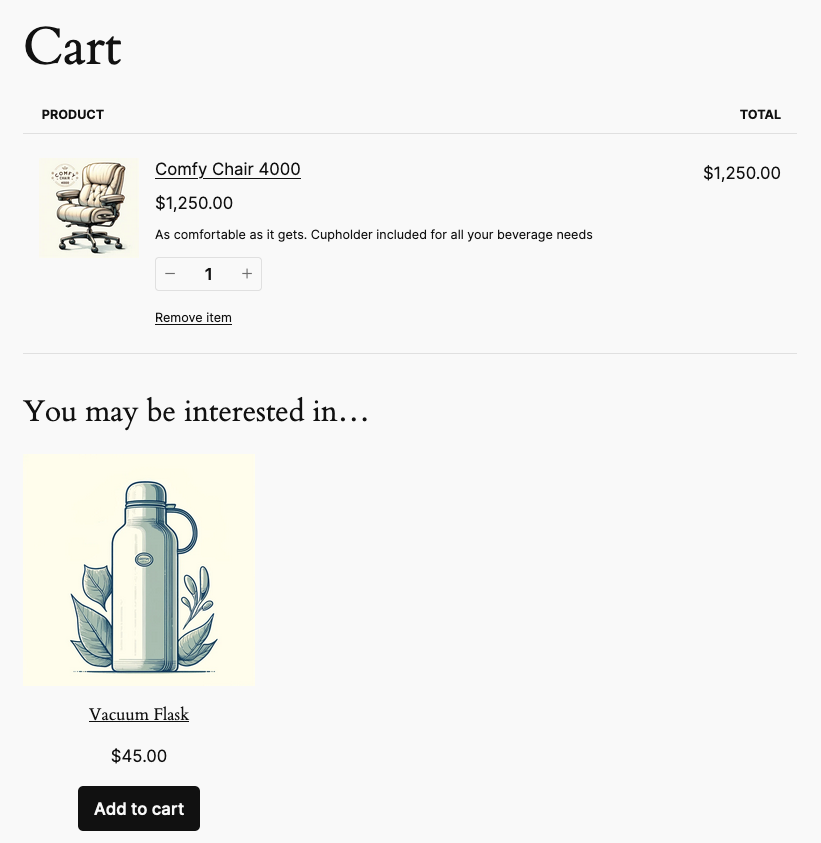
Attributes section
↑ Back to topThe Attributes section is for adding structured details to a product. All default product types show this section from where to add either pre-configured Global attributes (see Managing Product Categories, Tags and Attributes) or new attributes (which would be available to the particular product only).
- Add new – It adds a New Attribute section to enter attributes for this product only, or you can choose an existing Global attribute from the “Add existing” dropdown instead.
- Add existing – a dropdown populated by the Global attributes configured under Products > Attributes.
- New attribute
- Name – the name of attribute, e.g. Color.
- Value(s) – the values of the attributes, e.g. Red | Blue | Yellow.
- Visible on the product page – if checked, attributes appear in the Additional Information section of the single product page (visibility depends on the design of your theme or page builder).
- Used for variations – only applicable to Variable product types. Checking this box makes the attribute available for use in the Variations section of a Variable product.
Variations section
The Variations section lets you create variations for a Variable product, and you can find detailed information about it here.
Advanced section
The Advanced section contains the following settings:
- Purchase note – only available for Simple and Variable products. An optional note appears below the product on the order confirmation screen and in order-related emails.
- Menu order – custom ordering position for this item. When displaying products in the shop, WooCommerce outputs products from lowest to highest menu order. Products that have the same menu order are output alphabetically. When you use other sorting methods, this setting becomes secondary. (e.g. when sorting by popularity)
- Enable Reviews – enable/disable customer reviews for this item. Learn more about managing reviews.
Product short description
↑ Back to topThe Product short description is a succinct summary long description. This typically appears next to product imagery on product listing pages. You can embed videos here as well.
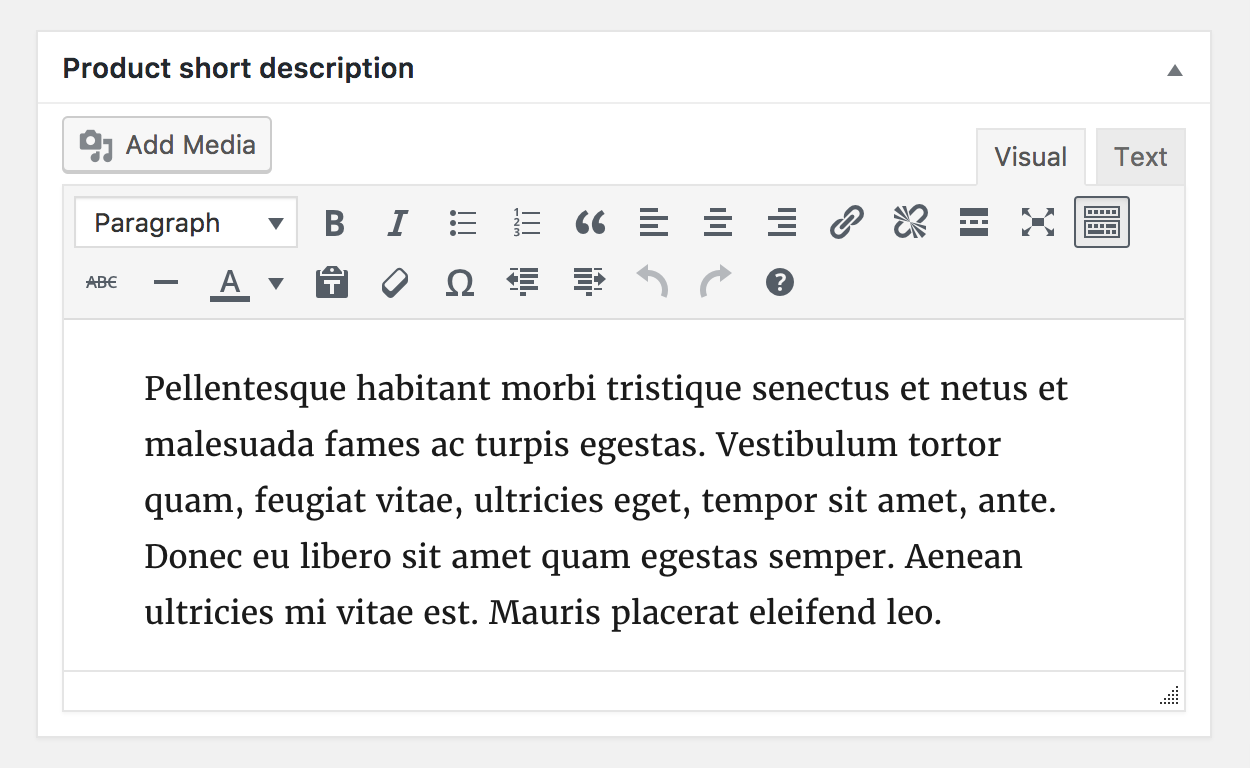
Publish – Visibility, Catalog Visibility
↑ Back to topThe Publish panel indicates the product’s published and visibility status. You can also use it to set catalog visibility options and feature status.
- Save Draft – save changes while in draft mode. The button disappears once you publish the product.
- Preview – show a preview of the product’s current state. Especially useful to see what changes look like before saving.
- Status – shows the published status of a product. Includes the following options:
- Published – the product is accessible to customers.
- Pending review – A site admin must approve the product before it can be published, so customers can’t see it yet.
- Draft – not yet published.
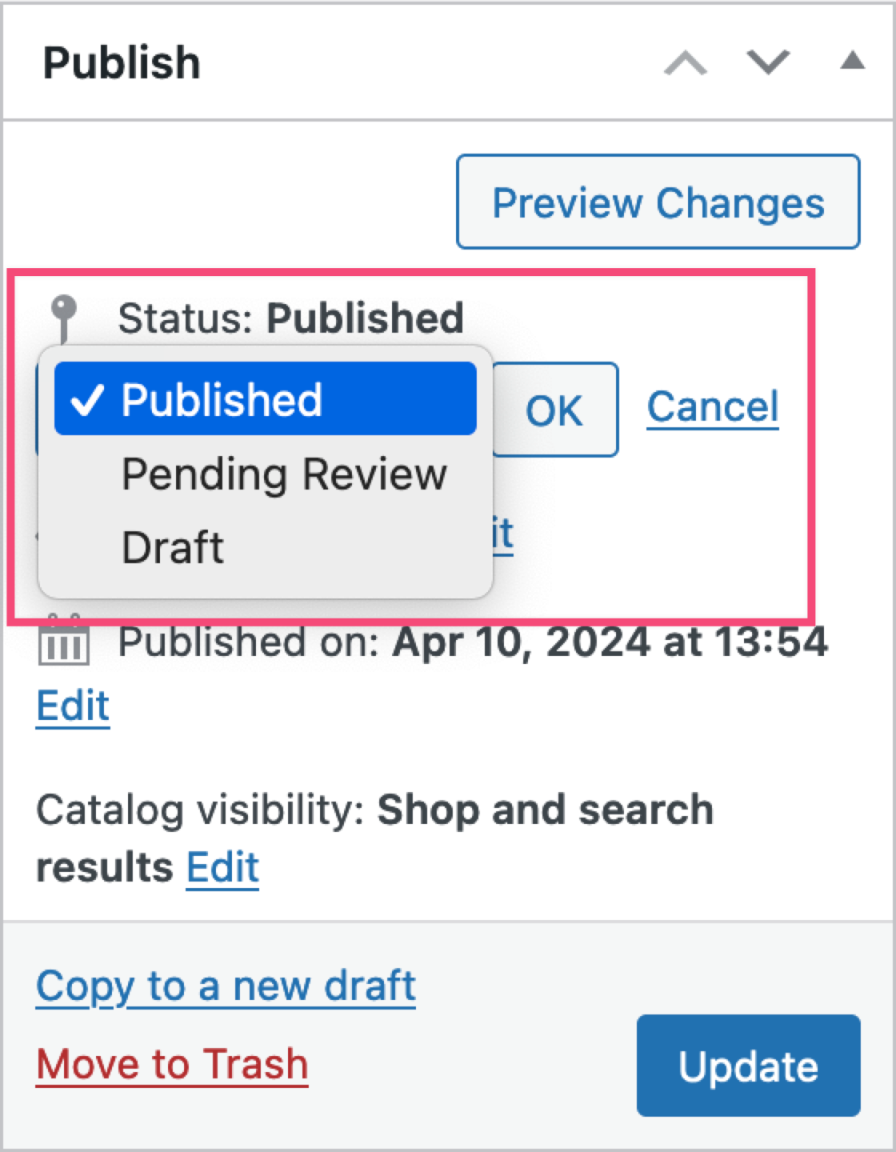
- Visibility – allows a product’s content to be conditionally visible, based on these options:
- Public – the default, means a page and all its content are accessible without restrictions.
- Password protected –The product appears in the catalog, and everyone can access the page, but they need a password to view the content. Useful to demo a product or give conditional access to a select few.
- Private – After publishing, only site Admins and Editors can view the product.
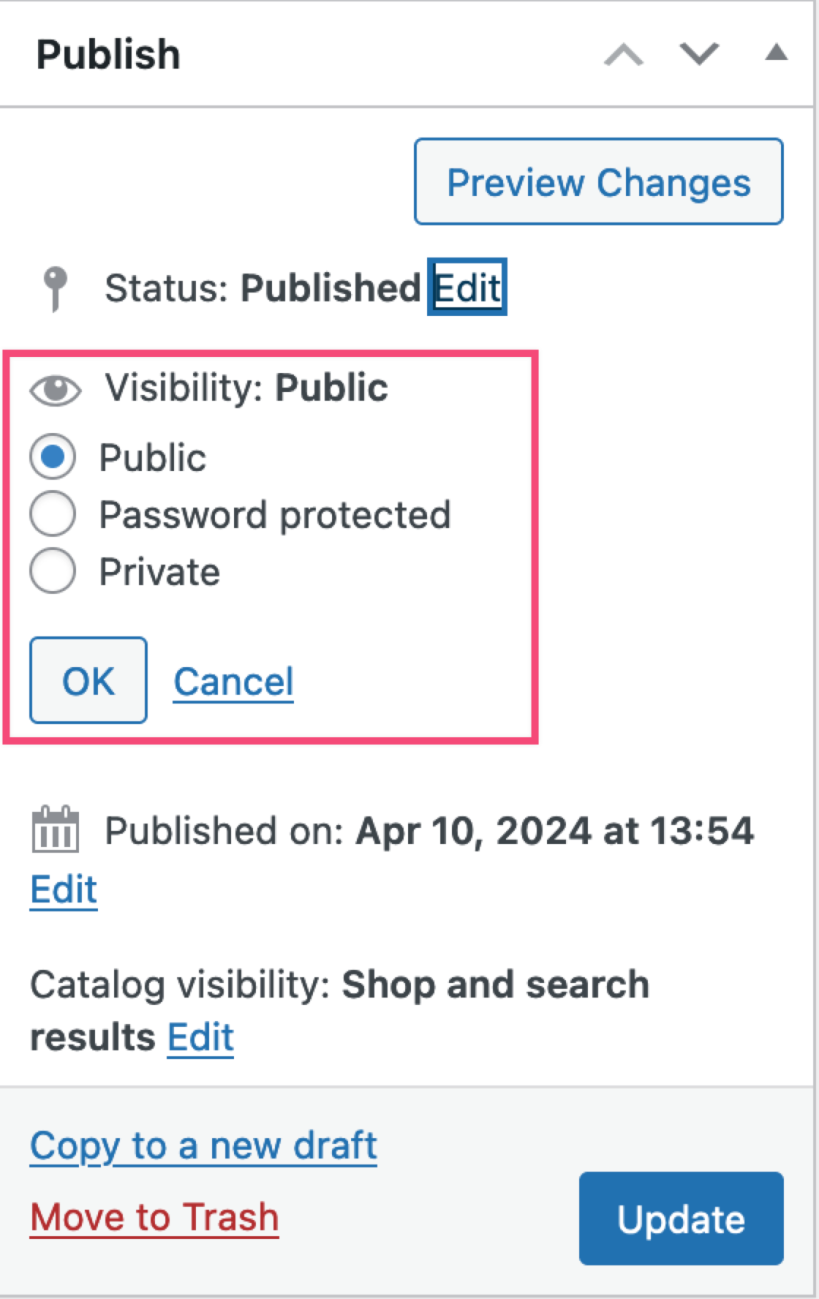
- Published on – After you publish the product, it shows the date and time of publication. To change these details, click the “Edit” link.
- Catalog visibility – The Catalog lists all your products displayed on pages like the Shop page, product collections, categories, and more.. You can determine where and how Published products appear via the following options:
- Shop and search – the default, visible everywhere, shop pages, category pages and search results.
- Shop only – visible in shop pages and category pages, but not search results.
- Search only – visible in search results, but not in the shop page or category pages.
- Hidden – only visible on the single product page, and nowhere else.
- This is a featured product – checking this option gives prominence to the product for promotions across various sections of the shop that promotes featured product. It’s equivalent to clicking the Star next to the product in the Product list view.
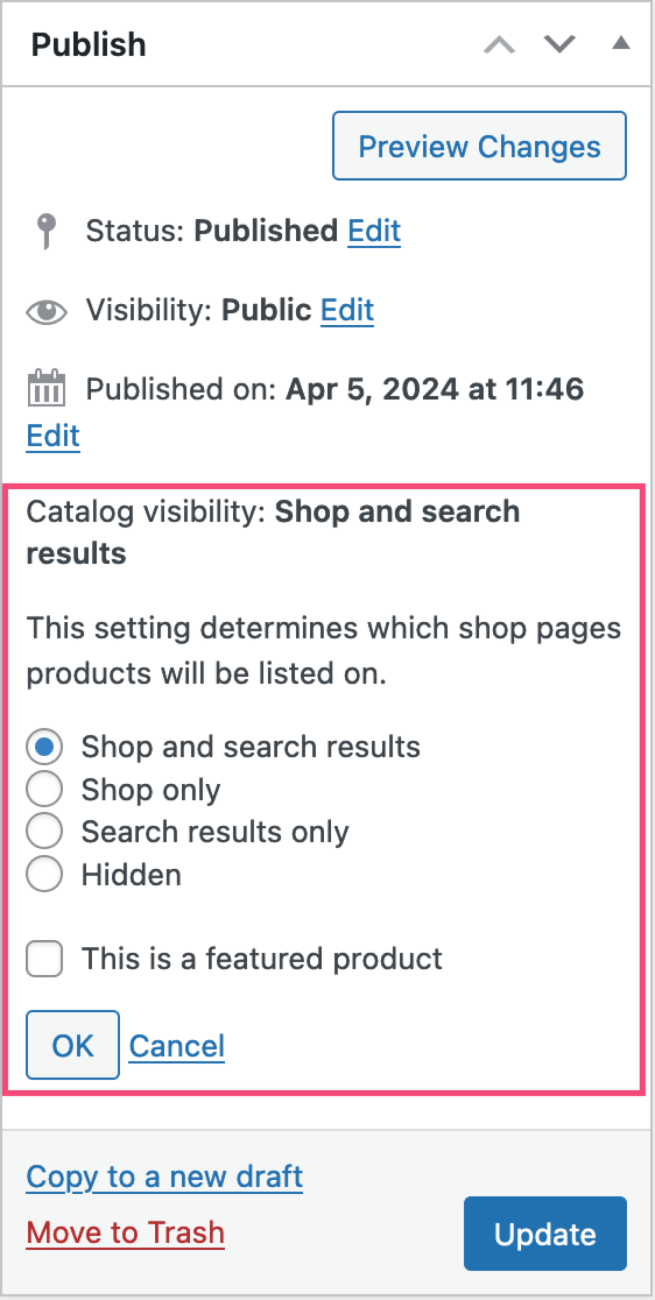
- Copy to a new draft – Clicking the button copies the product and all its settings as a new product, adding “(Copy)” to the Product name. Useful when adding products with similar settings.
- Publish/Update button – While the product is in Draft or Pending review, the button displays as “Publish” (so use the “Save Draft” button to save changes). After you publish the product, the button changes to “Update.”
Product images and Product gallery
↑ Back to topAdding a Product image shows prospective customers what they’re purchasing. It builds customer confidence, makes the product offer visually appealing, and adds an element that search engines and social media use to enhance offsite listings as well, increasing click-through rates to your site.
Adding additional images via the Product gallery multiplies that effect.
Click here for a detailed guide on how to add a product image and product gallery.
Product categories
↑ Back to topProduct categories and product tags are specific to Products, but work in much the same way as categories and tags do when for posts in WordPress. The Product categories panel contains the following:
- All categories – a list of existing product categories. Check one or more categories to which you want to add this product.
- Most used – a view that shows a selection of only the most frequently used product categories.
- Add new category link – for adding new categories. Clicking it reveals:
- a new field for adding new category name.
- Parent category – assign a parent for the new category to nest your new category inside an existing category.
- Add new category button – required to add the new category.
The panel above allows you to quickly manage a store with only a few categories. However, the Managing Product Categories, Tags, and Attributes documentation explains another way to handle a large number of categories in detail.
Product tags
↑ Back to topSimilar to categories, Product tags function much like WordPress post tags do. Type a new tag into the field provided and click the Add button. The newly added tag shows up below the field with an “x” that you can click to remove it. After you add and save tags, you can access them by clicking “Choose from the most used tags” and then selecting an option from the revealed list.
The Managing Product Categories, Tags, and Attributes documentation explains another way to manage tags in detail.
Is it possible to edit several products at the same time?
↑ Back to topYes. Refer to Bulk Editing Products.
Questions and Support
↑ Back to topDo you still have questions and need assistance?
This documentation is about the free, core WooCommerce plugin for which support is provided in our community forums on WordPress.org. Searching there you’ll often find that your question has been asked and answered before.
If you haven’t created a WordPress.org account to use the forums, here’s how.
- If you’re looking to extend the core functionality shown here, we recommend reviewing available extensions in the Woo Marketplace.
- Need ongoing advanced support, or a customization built for WooCommerce? Hire a WooExpert agency.
- Are you a developer building your own WooCommerce integration or extension? Check our Developer Resources.
If you weren’t able to find the information you need, please use the feedback thumbs below to let us know! 🙏